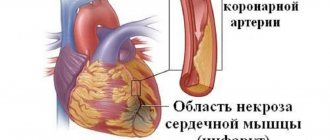Preparation
Heart surgery during a heart attack is impossible without a number of diagnostic measures:
- Ultrasound of the heart;
- ECG;
- EchoCG;
- scintigraphy;
- coronary angiography;
- a blood test that shows whether it contains troponin, a contractile protein that is not found in healthy people.
After providing an accurate diagnosis, the doctor will decide what kind of operation will be: emergency or planned. The first is always riskier than the second, because there is practically no time to prepare for it.
Important! Coronary angiography is performed before each heart surgery to check how damaged the vessels are. To do this, a catheter is inserted through the femoral vein up to the aortic valve and contrast is passed through it, which will give a clear picture of the state of the patient’s vascular system. An X-ray machine monitors and records the process, data from which will be added to the patient’s medical history.
Surgery for myocardial infarction can be performed in 2 ways:
- Transdermal.
- Open.
Which option will be better is decided individually. However, there are some general points:
- what is the condition of the coronary bed;
- how far myocardial necrosis has spread;
- how stable is the heart function;
- general condition of the patient, etc.
The patient is carefully examined for compatibility with the drugs used in therapy, especially with contrast, and the Rh factor and blood type are rechecked. The operation will help eliminate the consequences of the root cause of the disease, but not the disease itself.
Emergency surgery for myocardial infarction
Surgery for myocardial infarction is necessary in most cases. It helps restore heart function and improve blood flow. Without surgery, the risk of death is high, so if an acute heart attack is suspected, the patient must be urgently taken to the hospital and undergo the necessary examinations. First of all, the wall of the damaged vessel is examined.
The importance of timely surgery
Currently, the most popular procedure performed for a heart attack is CABG (coronary artery bypass grafting). In 13 hospitals in the capital, another operation is performed - balloon angioplasty. Soon 7 more medical institutions will be added to their number.
This type of surgery involves not only eliminating coronecrotic tissue, but also preventing further problems. For example, glioblastoma of the cephalic vein as a result of long-term oxygen starvation. The practice of such innovation is not yet extensive enough.
In case of myocardial infarction, heart surgery cannot be done at will: it is mandatory. Due to the attack, part of the muscle tissue dies. Along with it, one of several veins or arteries fails.
It is clogged by a thrombus element, resulting in either a cessation of blood circulation or a rupture of the vascular connection.
In the absence of surgical intervention, death follows this phenomenon.
Surgeries reduce the risk of death, but do not eliminate the disease completely. It is important to remember that complications that are incompatible with life may arise due to the fault of doctors or the patient.
Correctly carried out actions eliminate the consequences of a heart attack, and staying in intensive care and hospital reduces the risk of a recurrence of the problem. But in the future, the patient himself must maintain his health by taking medications and an appropriate lifestyle.
Prognosis after surgery
The effectiveness of surgery depends on the time it is performed. In case of myocardial infarction, there is a need to perform surgery no later than 6 hours from the moment the problem appears. If you eliminate the blood clot and transplant the vein within the first hour, then there will be no negative consequences for the body.
If surgeons intervened after the first hour from the moment of the heart attack, side problems are possible:
- The risk of a recurrent attack increases.
- An aneurysm develops.
- The chance of developing a stroke increases.
- Organs adjacent to the heart may be damaged, this process can affect the kidneys and bile duct.
Given these data, at the first signs of an acute necrotic process, the patient should be taken to the hospital as soon as possible. There the cause of the deviation and treatment options are determined.
Is surgery for an acute heart attack performed for those who fall into the category of hopeless patients? Even with negative assumptions, surgical procedures begin, but are rarely successful.
Disappointing prognoses are made if the operation after a heart attack began 6 hours after the moment of necrosis. During this time, heart cells can become completely dead. The result will be a cessation of beating of the main muscle of the body and death.
After myocardial damage, additional body resources are activated to ensure blood circulation. But in very rare cases they last more than 6 hours.
Preoperative procedures
When a patient is taken to the hospital, coronary angiography is mandatory. It allows you to make assumptions about the size of the affected area of the heart. Based on these data, instruments for the operation are selected and the exact method of surgical intervention is determined.
If a patient is admitted with a suspected blood clot, but a heart attack has not yet developed and the heartbeat is normal, he is referred for additional examination. It includes coronary angiography and cardiac echo. Secondary information is collected.
Reasons for refusing surgery may include:
- diabetes;
- concomitant vascular diseases or heart failure;
- extensive necrosis of the arteries or a number of diseases of the circulatory system.
Additional surgical procedures allow you to adjust the level of anesthesia and choose the optimal type of intervention. In the case of a weak body, only supportive procedures are carried out, and the removal of a blood clot is prescribed after a heart attack has occurred.
- Clear the chest of hair so that nothing interferes with making the incision.
- Calculate the required dose of anesthesia;
- Sign some papers (the patient’s consent or refusal regarding the medications and procedures used).
If a person is admitted to the hospital with an already progressing heart attack, then heart surgery is performed urgently. It is carried out without preliminary preparation. The only necessary measure is coronary angiography, which does not take much time.
Stages of the operation
Before the operation begins, the surgeon’s task is to provide the patient with the most comfortable conditions of stay, high-quality anesthesia and a life support system.
During the intervention, a heart-lung machine is connected, which performs the work of the heart.
You also need a device to ensure breathing and a carefully prepared operating room with all instruments and one hundred percent hygiene.
The first step during the operation is an incision that is made on the chest. It is needed so that surgeons can get to the heart and carry out the necessary manipulations with it. The integrity of the periosteum is compromised.
All incisions must be made very carefully so as not to touch large vessels and not cause anemia or death from blood loss. Sometimes it can be too difficult to find the veins around the heart because they are blocked by fatty deposits.
To make the capillaries appear and make it easier to understand how many of them lie in the operated area, in case of an acute heart attack a heart massage is first performed.
Source: https://tepcontrol.ru/ekstrennaya-operatsiya-pri-infarkte-miokarda/
Stenting
Stent placement is often compared to balloon plasty. Often these two methods of percutaneous intervention are combined for greater effectiveness. A mesh ring is placed on the balloon - a stent, which will be installed after the deflated balloon is removed. The mesh does not shrink and remains in the vein.
This technique is one of the least invasive; hospitalization after it is minimal, as well as death. The patient quickly returns to normal. The downside is that the patient needs to constantly take medications that affect the blood. Liquefaction avoids blood clots near the stent, but this possibility cannot be ruled out and can lead to repeat surgery after a heart attack.
Therefore, clinics now prefer to work with modern stents that are impregnated with substances that prevent thrombosis.
Balloon angioplasty and stenting
Percutaneous intervention can be performed simultaneously with coronary angiography. If endovascular surgery is performed separately, a long catheter is advanced into the heart through the inguinal vein and contrast is injected under X-ray control. The vascular pattern of the heart is visible on the monitor screen.
Next, the surgeon passes through the narrowed area with a catheter with a balloon, which, when inflated, opens the artery and restores blood flow to the myocardium. The manipulation can be completed here. The balloon is removed after deflation. The patient is discharged after 3 days. But the narrowing often repeats itself. In order to stably ensure the delivery of oxygen, a mesh spiral is installed in the area of the vessel narrowed by the plaque.
Sometimes stenting is performed as a separate procedure. The manipulation is similar to balloon angioplasty. The difference is that a stent is mounted on the balloon - a special cylindrical spiral made of metal or plastic. During the procedure, the balloon is inflated, opening the mesh. The next moment, the balloon is deflated, and the mesh remains in the narrowed place. After endovasal intervention is completed, the catheter with the balloon is removed.
Intravascular angioplasty is performed in emergency cases with a large heart attack. The modern technique has advantages. Bloodless and painless manipulation lasts only 20–30 minutes. The patient recovers on the operating table and is quickly discharged. The disadvantage of the operation is the dependence on antiplatelet agents - drugs that prevent thrombosis at the site of mesh installation. The duration of taking Aspirin and Clopidogrel is from 6 months to a year.
The walls of the blood vessels may narrow again after some time. To prevent this from happening, the most suitable option of all possible is used, which includes the stenting technique. The essence of the method is the use of special cylindrical stents made of plastic or metal. Stents are inserted into the vessels and expand them to an acceptable size.
Often, stenting, which is prescribed after a myocardial infarction, is combined with dilatation: in this case, the stent is attached to a balloon, which expands it during inflation. This technique is considered more gentle, since the patient’s recovery process is noticeably faster, and a noticeable improvement in the condition is also observed.
The list of operations prescribed for a heart attack also includes laser-type angioplasty, during which a thin catheter is inserted into the heart artery. Thanks to angioplasty, it is possible to quickly eliminate cholesterol plaques that interfere with proper blood flow. They are eliminated with a laser: during the operation, the surgeon finds the damaged artery and acts on it with a laser beam, which allows the plaque to dissolve, turning it into gas.
Coronary angiography
Balloon transluminal dilatation
The essence of the procedure is that a small incision is made in the coronary artery affected by the disease, through which a catheter with a balloon at the end will be inserted into it. At the site of narrowing of the artery, it is inflated to increase the lumen in the coronary vessel. This will restore blood flow. Then the balloon will be removed, and the back and front walls of the artery will return to normal. The process is monitored by an X-ray machine.
Both the patient's arm and leg can be used for the operation. The disadvantage of the procedure is the likelihood of repeated narrowing of the vessel, which will lead to a disruption in blood flow. To avoid this, balloon transluminal dilatation is performed in conjunction with stenting.
Types of operations
What kind of surgery is performed for a heart attack depends on the patient’s condition. When choosing a surgical method, the degree of:
- stability of the heart muscle;
- coronary lesions;
- spread of necrosis on the cardiac myocardium.
Operations are divided into 2 types:
- percutaneous, or minimally invasive;
- open.
Advantage in the surgical treatment of infarction is given to percutaneous operations. Minimally invasive procedures have minimal risks of complications. The absence of the need for open access greatly shortens and simplifies the rehabilitation period.
Percutaneous intervention
Percutaneous techniques include:
- balloon dilatation;
- stenting;
- laser angioplasty.
In many cases, several minimally invasive techniques can be combined simultaneously to treat cardiovascular pathologies that lead to a severe heart attack.
Important information: Symptoms and treatment options for abdominal myocardial infarction
Stenting
This type of surgery involves installing a special stent in a blood vessel, which prevents the vessel from narrowing over time (narrowing leads to poor circulation, and a heart attack can happen again)
A stent is a mesh that, when expanded in a blood vessel, expands and fixes its walls to the required volume. A stent is inserted into a hollow blood vessel. In case of myocardial infarction, surgery is performed under the control of X-rays and optical equipment.
A heart attack after this surgical intervention may occur again, because, despite the effectiveness of this technique, it does not eliminate the very cause of the pathology. Over time, narrowing of the walls may occur on another blood vessel.
Balloon transluminal dilatation
This type of minimally invasive surgery involves making a small incision in the coronary artery through which a catheter equipped with a balloon is inserted. In the place where the walls of the vessel are strongly narrowed and impede normal blood circulation, the balloon is inflated, as a result of which the walls expand, normal blood flow is restored.
After removing the balloon, the walls of the vessel remain in the corrected position. An artery of the upper limb can be used for the procedure. Balloon dilatation is performed under the control of X-ray equipment.
The disadvantage of this technique is that there is a possibility of repeated narrowing of the arterial walls. To prevent this complication, balloon dilatation is performed in conjunction with stent placement. First, the walls of the artery are expanded with a balloon, then a mesh is installed to prevent repeated narrowing of the bloodstream.
Excimer angioplasty with laser
Percutaneous laser angioplasty is a modern method of surgical treatment of infarction. The advantage of the procedure is the minimal risk of damage to the artery.
To expand the walls of the vessel, an excimer xenochloride type generator is used, which generates ultraviolet waves. Under their influence, a blood clot is destroyed in a blood vessel, preventing full blood flow.
Important information: What medications to take after myocardial infarction
Alternate heating and cooling of the thrombus by waves helps to completely wash out its particles from the artery. To heat and cool the clot, saline solution is injected into the bloodstream through a catheter.
Open type intervention
Surgeries for myocardial infarction, requiring open access to the heart muscle, are of the following types:
- removal of aneurysm;
- shunting.
Objectives of open operations:
- elimination of neurosis and tissues affected by it;
- activation of rapid regeneration and healing processes;
- normalization of blood circulation with the exclusion of damaged vessels;
- restoration of full functioning of the heart muscle.
Although open operations are technically more complex than percutaneous operations and have risks of complications, they provide the maximum effect in the treatment of infarction.
Vascular bypass surgery
The operation helps eliminate heart defects that are irreversible. The duration of the operation is about 4 hours. During the operation, the patient must be connected to a heart-lung machine.
During surgery, a special shunt is sewn into the damaged artery, which restores blood circulation. To perform a bypass, it is necessary to make a cavity incision in the sternum. For shunts, biological materials from the patient are used - the femoral vein, the radial artery from the arm.
Aneurysm excision
This method of surgical treatment of myocardial infarction is the most difficult. During the operation, the chest is opened, the doctor gains open access to the heart muscle. The goal of the procedure is to restore blood circulation using cardiac chambers, removing damaged connective tissue and dissolving blood clots.
If necessary, the walls of the heart are strengthened using the technique of suturing them with special connecting materials. Excision of an aneurysm is a complex surgical procedure after a heart attack; there is a risk that the patient’s body will not tolerate the load during the open operation.
Important information: A set of exercise therapy exercises for recovery after myocardial infarction at home
Pacemaker device
This method of surgical treatment of myocardial infarction is minimally invasive and is considered an emergency way to restore heart function when the case is acute and there is no time to examine the patient to identify the exact location of the damaged coronary vessel.
The method is that electrodes are connected to the areas of the myocardium in which there is the least degree of resistance. Algorithm:
- administration of local anesthesia;
- an incision made parallel to the line of the collarbone;
- insertion of electrodes into a small vein;
- attaching electrodes to a pacemaker;
- implantation of a pacemaker into adipose tissue;
- suturing the incision.
The surgical procedure is performed under X-ray control.
Excimer angioplasty with laser
This is the most modern and effective method of percutaneous surgical intervention for a heart attack. With it, the elimination of atherosclerotic tissue occurs with minimal impact on the walls of the coronary vessel, which virtually eliminates their injury. For this purpose, an excimer xenon chloride generator is used, which produces UV waves with a minimum length.
Under the influence of periodic pulses, the liquid evaporates, which leads to acoustic waves that travel along the inner wall of the artery and destroy blood clots in it. The process involves heating and cooling to flush blood and contrast out of the catheter.
This is helped by saline solution, which is constantly administered throughout the procedure. Ablations – laser treatments – last for 5 seconds of heating and 10 seconds of cooling. This allows the doctor to determine the location of the catheter tip and monitor the process.
Rehabilitation and complications
After surgery for a heart attack, the patient must remain in a hospital setting for at least 10 days under the constant supervision of medical personnel.
It is imperative to follow a diet excluding fatty and fried foods and salt. Diet is necessary to prevent severe postoperative consequences - the formation of blood clots, the development of atherosclerosis, and increased blood pressure. After open operations, daily suture treatment is carried out. To prevent the formation of blood clots, anticoagulants are prescribed.
After discharge, daily breathing exercises, a gradual increase in the intensity of physical activity, and a diet are prescribed. 3 months after surgery, the patient must undergo a stress test, which shows the degree of saturation of the heart muscle with oxygen and how well the rehabilitation period is proceeding.
- blood clot formation;
- heart failure;
- stroke;
- kidney dysfunction.
After excision of an aneurysm, there is a risk of developing arrhythmia and accumulation of blood in the pericardium. The likelihood of developing all these complications is inherent mainly in open operations.
Vascular bypass surgery
This procedure helps prevent irreversible deformations of the heart muscle, which improves myocardial contractility, and therefore prolongs life and its quality. The procedure takes about 4 hours, during which both the surgeon and his entire team must be as concentrated as possible.
It is performed using a heart-lung machine. According to indications, they also operate with a beating heart. How long it will last and how the bypass will be performed depends on how damaged the coronary vessels are, and whether an additional procedure, for example, valve reconstruction, is necessary.
Also read: Abdominal infarction - features of manifestation and treatment
Advantages of coronary artery bypass grafting:
- traumatic damage to blood cells is excluded;
- the procedure requires less time compared to other similar interventions;
- rehabilitation is faster;
- fewer complications.
Currently, grafts from:
- internal thoracic artery;
- radial artery;
- great saphenous vein of the lower extremities.
The last two are performed both open and endoscopically. This affects the appearance of the incision and the length of recovery.
Aneurysm excision
A large heart attack is treated by excision of the aneurysm, which in surgery is considered a very complex procedure. In this case, the doctor needs to open the chest to have wide access to the heart. Afterwards, the blood flow through the heart chambers is stopped and carried out through the main vessels using a special pump.
The essence of the method is cutting off the bag and removing the affected connective tissue. If there are blood clots in the ventricle of the heart, they will also be removed. The heart wall is sutured. In some cases, special connecting materials are used to make it stronger. Often this procedure is combined with bypass surgery, which eliminates anginal-type pain and will prevent future recurrence of the disease.
Undesirable consequences after excision of an aneurysm:
- blood will collect in the pericardium;
- CH is left-sided type;
- blood clot formation;
- arrhythmia.
Taking special tablets helps avoid this. If a diagnosis of “false aneurysm” is made, the doctor will simply suture the defect, cut the adhesions of the pericardial layers and remove the blood from it. The procedure lasts several hours and is performed under general anesthesia. Doctors spend most of their time opening the sternum and inserting a device for artificial blood pumping.
Important! When excising an aneurysm, the probability of death if the procedure is performed correctly is about 10%.
How and why arrhythmia is treated with cauterization
The operation has another name - “ablation”. It refers to minimally invasive interventions and is included in the section of endovascular surgery. It is not prescribed for every person. When a pathological focus forms, in which the normal conduction of electrical impulses changes, treatment is required.
When cauterizing the heart during arrhythmia, a focus of necrosis is created artificially, in which cardiomyocytes are no longer able to perform their functions. Under the influence of the rays, a blockade is formed. It prevents the occurrence of impulses produced by the pacemaker at the moment of myocardial relaxation (diastole). They disrupt the functioning of the heart, which can lead to negative consequences.
The following indications are identified when surgery is considered vital:
- Atrial fibrillation, when it appears, is diagnosed and treated with medication. The muscle fibers begin to contract out of sync, as they should in a healthy person. A circulation of impulses is created, and a pathological focus of excitation is formed in a certain area in the patient’s atrium. After some time, if there is no positive dynamics, or progression of the condition is observed, ablation is prescribed.
- Ventricular type tachycardia. This violation is considered the most dangerous. The person's heart rate increases and fibrillation may develop. It can lead to cessation of myocardial activity (asystole).
- Rhythm disturbances of other forms in which it is advisable to use surgical intervention.
- A disorder of the myocardial conduction system, which after a certain time will lead to complications without treatment. It is most often congenital, which entails a tendency to rhythm disturbances.
- Enlargement of the heart (cardiomegaly) and insufficiency of its activity.
It is important to consider the likelihood of adverse outcomes. To significantly reduce the risk of their occurrence, cauterization is performed only after eliminating contraindications for the procedure. If diabetes mellitus is present and the patient is over 75 years of age, the issue is resolved individually.
Pacemaker device: installation
Sometimes it is impossible to delay surgery for a heart attack. When an attack is acute, an urgent procedure is required, the necessity of which is the full responsibility and prerogative of the doctor. The required method is selected individually, and in some cases this is the installation of a “pacemaker” device. With it, the chance for a full life is higher, as is the patient’s survival when cardiac dysfunction has reached its climax.
This is a device that controls the work of the heart muscle, forcing it to contract correctly, which is helped by a special spring. It is important that the “pacemaker” detects a malfunction in the functioning of the heart muscle and turns on. Doctors use IVRs consisting of 1-3 chambers to regulate problematic heart cavities.
The procedure is carried out as follows:
- The patient is given local anesthesia.
- An incision is made that runs parallel to the collarbone.
- Electrodes are inserted into a small vein. Everything is monitored by an X-ray machine to identify areas of least resistance where they will be connected.
- On the other hand, the electrodes are connected to a pacemaker implanted into the subcutaneous fat. This is how the device is positioned when installing an endocardial type; if it is an external placement, then the block will be in the abdominal cavity.
- Stitch up the wound.
The price for such devices starts from $550.
Potential Complications
Adverse consequences from a heart attack do not occur immediately. Complications can develop gradually and affect not only the heart, but also other organs. The greatest danger to a person is the first year of life after a heart attack. It is during this period that most of the consequences that lead to death occur.
Complications often occur in the form of such diseases:
- Heart failure.
- Extrasystole.
- Aneurysm.
- Thromboembolism of the pulmonary artery.
- Thromboendocarditis.
- Pericarditis.
It is known that, in principle, a person does not die from an uncomplicated heart attack. Death occurs from complications. What are the complications of coronary thrombosis? Isn't a dead section of the heart enough? It turns out not enough. A heart attack can be complicated by:
- Pulmonary edema (shortness of breath, cyanosis, cold sweat, cough with foamy sputum, wheezing, foam at the mouth);
- Cardiogenic shock, which develops against the background of an extensive heart attack and is associated with a decrease in cardiac function, includes pain and arrhythmic shock;
- Ventricular fibrillation, which is the most dangerous rhythm disorder. Without defibrillation, death is inevitable. Develops already in the first hours after the onset of a heart attack;
- Ventricular extrasystoles, idioventricular rhythm and other arrhythmias;
- Impulse conduction disorders and severe blockades;
- Asystole (complete electrical “silence” of the heart);
- Rupture of the heart (wall of the left ventricle). Occurs with an extensive transmural zone of necrosis;
- Intracavitary thrombosis;
- Rupture of the interventricular septum and separation of papillary muscles and heart valves.
In addition to these very severe complications, some of which are certainly fatal, myocardial necrosis in the right ventricle may occur as a complication of necrosis on the left.
To top it all off, after a large number of muscle structures enter the bloodstream, Dressler's syndrome develops, associated with autoimmune inflammation, and is manifested by fever, polyarthritis and pericarditis. It occurs 2 weeks after a heart attack.
Complications often occur after open surgery. Such interference may cause the following consequences:
- vascular thrombosis;
- anemia;
- heart failure;
- stroke;
- impaired renal function.
Heart attack surgery can be performed in various ways. The appropriate option is selected individually according to indications. After surgery, the rehabilitation period is important. If you follow the specialist’s recommendations, the risk of possible complications is significantly reduced.
Complications may occur after surgery for myocardial infarction. This often happens as a result of an inflammatory process at the surgical site. But inflammation is not provoked by infection, but by the body’s response to interference in its work. There may be:
- temperature increase;
- weakness;
- arrhythmia;
- chest pain;
- painful sensations in the joints.
In rare cases, non-union of the sternum, blood clots, and renal dysfunction occur. After bypass surgery, the patient may experience breathing problems. It is restored with the help of special exercises. The most unpleasant complication is narrowing of the shunts, in which case it will be necessary to perform a second shunt.
The risk of complications increases due to poor condition of the heart muscle, significant disturbances in the functioning of the left ventricle, chronic heart failure, and diabetes mellitus. In women, heart attack operations are more difficult. In female representatives, atherosclerosis develops later, that is, older patients with many chronic diseases and poor health are admitted for surgery.
If the patient had a valve installed, or the doctor needed to insert a stent into several vessels, as well as in a number of other operations during a heart attack, complications may arise. Often, inflammation develops at the surgical site, which is caused not by an infectious process, but by a response from the body.
Recovery after surgery
Before performing one of the types of surgery described above, the surgeon assesses possible risks and complications, takes into account the patient’s condition and age, as well as the presence of other diseases for which surgical interventions are contraindicated. In the presence of diabetes mellitus, chronic heart failure, or problems with the functioning of the left ventricle, patients may experience complications, which in some cases can be corrected immediately after surgery. The video below explains in detail the procedures of stenting and angioplasty.
Rehabilitation
After surgery, the patient requires emergency care, which is carried out in the intensive care unit for at least 10 days. In addition to following a diet that prevents atherosclerosis, varicose veins and the formation of blood clots, the patient’s heart, lungs and other important systems of the body are restored. If there are postoperative complications, they will be actively addressed at this stage. The seams are being processed. Complete healing of the chest takes about 6 months.
Upon leaving the intensive care unit, the patient is transferred to a regular ward, where he will be prescribed breathing exercises, a gradual increase in physical activity and good nutrition. Both in the hospital and after it, the patient will take antithrombotic drugs, drugs for normal heart function. Symptomatic treatment is carried out if necessary.
Rehabilitation after surgery
To minimize the risk of complications, you need to undergo proper rehabilitation after a major intervention. The patient spends the first days after surgery in the intensive care unit, where the heart adapts to operating conditions. This takes about 10 days. All this time, the seams are treated with antiseptics and dressings are made. After 14 days, the stitches can be removed.
After the sutures are removed, physical activity is increased. At first, a quiet walk is allowed for a distance of up to 1 km, the distance is increased. After surgery, all patients are recommended to recuperate in a sanatorium-resort setting, which provides a rehabilitation program after a heart attack.
Three months after the operation, a stress test is performed - the patient is asked to perform a series of exercises, and at this time the doctor evaluates the operation of the shunts using devices for saturating the myocardium with oxygen. If everything is in order, you can return to work - it all depends on the patient’s age, general health and the nature of work.
The prognosis is mostly favorable - decades of active life. The main thing is to follow the recommendations of doctors and monitor your health.
Complications
Open heart surgery subsequently requires a complete change in life and a long recovery period. The most dangerous are the first 3 days after the intervention, when there is a high risk:
- vascular thrombosis;
- occurrence of stroke;
- heart failure;
- anemia;
- kidney failure;
- No fusion of chest bones, etc.
If you seek help in a timely manner and are careful about your health, even a heart attack can be cured and complications after it can be avoided. You will have to drink a lot of vitamins and iron to restore the body. Life doesn’t always return to normal, but it does, and that’s the main thing.
Indications and contraindications
In case of a heart attack, heart surgery is an emergency method of treatment; it is performed only in cases where the acute course of the pathology has been missed or long-term use of medications aimed at restoring the function and condition of the heart muscle does not produce a positive effect.
Contraindications for surgical treatment:
- more than 1 artery is affected at the same time;
- hepatitis;
- diabetes;
- necrosis affecting a large area of soft tissue;
- cardinal and irreversible change in the heart;
- scars formed on the heart muscle;
- aneurysm;
- rupture of the pancreas.
Surgery for these conditions is fraught with dangerous complications that are difficult to correct and can cause death.











